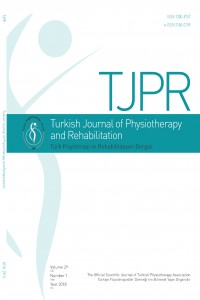Öz
Purpose: This study was aimed to investigate the relationship between postural control and hand function in the elderly.
Methods: One hundred-five elderly individuals that are 65 years old or over and living in a nursing home were included in the study. Postural control status (Berg Balance Scale) and hand function (manual dexterity: Nine Hole Peg Test, hand grip strength: handheld dynamometer, pinch grip strength: pinchmeter) of elderly individuals were evaluated.
Results: The mean age of the subjects was 76.59±6.92 years, and there were 25 females (23.8%) and 80 males (76.2%). There was a statistically significant correlation between postural control and manual dexterity (dominant hand: r=0.857, p=0.001 and non-dominant hand: r=0.794, p=0.001). A statistically significant correlation between postural control and hand grip strength (dominant hand: r=0.430, p=0.001 and non-dominant hand: r=0.423, p=0.001), and a statistically significant relationship was found between postural control and pinch grip strength (dominant hand: r=0.390, p=0.001 and non-dominant hand: r=0.305, p=0.002).
Conclusion: Our study showed that there was a significant relationship between postural control and hand function. This suggests that postural control-enhancing exercise programs might be useful. Therefore, we thought that further study is needed to investigate the effects of postural control to protect and improve the hand function for the elderly enhancing exercise programs for the elderly on the hand function to clarify the issue.
Anahtar Kelimeler
Kaynakça
- 1. Nair KS. Aging muscle. Am J Clin Nutr. 2005;81(5):953-63.
- 2. Ranganathan VK, Siemionow V, Sahgal V, Yue GH. Effects of aging on hand function. J Am Geriatr Soc. 2001;49(11):1478-84.
- 3. Bejor M, Mandrini S, Caspani P, Comelli M, Chiappedi M. Quantification of upper limb skills in elderly inpatients: a controlled study. Eur J Phys Rehabil Med. 2015;51(4):399-404.
- 4. Gillen G, Boiangiu C, Neuman M, Reinstein R, Schaap Y. Trunk posture affects upper extremity function of adults. Percept Mot Skills. 2007;104(2):371-80.
- 5. Sturnieks DL, St George R, Lord SR. Balance disorders in the elderly. Neurophysiol Clin. 2008;38(6):467-78.
- 6. Rosenblum S, Josman N. The relationship between postural control and fine manual dexterity. Phys Occup Ther Pediatr. 2003;23(4):47-60.
- 7. Voudouris D, Radhakrishnan S, Hatzitaki V, Brenner E. Does postural stability affect grasping? Gait Posture. 2013;38(3):477-82.
- 8. Fallang B, Saugstad OD, Hadders-Algra M. Goal directed reaching and postural control in supine position in healthy infants. Behav Brain Res. 2000;115(1):9-18.
- 9. Flatters I, Mushtaq F, Hill LJ, Holt RJ, Wilkie RM, Mon-Williams M. The relationship between a child’s postural stability and manual dexterity. Exp Brain Res. 2014;232(9):2907-17.
- 10. Keskinoglu P, Ucku R, Yener G, Yaka E, Kurt P, Tunca Z. Reliability and validity of revised Turkish version of Mini Mental State Examination (rMMSE-T) in community-dwelling educated and uneducated elderly. Int J Geriatr Psychiatry. 2009;24(11):1242-50.
- 11. Sahin F, Yilmaz F, Ozmaden A, Kotevoglu N, Sahin T, Kuran B. Reliability and validity of the Turkish version of the Berg Balance Scale. J Geriatr Phys Ther. 2008;31(1):32-7.
- 12. Earhart GM, Cavanaugh JT, Ellis T, Ford MP, Foreman KB, Dibble L. The 9-hole PEG test of upper extremity function: average values, test-retest reliability, and factors contributing to performance in people with Parkinson disease. J Neurol Phys Ther. 2011;35(4):157-63.
- 13. Shechtman O, Gestewitz L, Kimble C. Reliability and validity of the DynEx dynamometer. J Hand Ther. 2005;18(3):339-47.
- 14. Mathrowetz V, Weber K, Voli G, Kashman N. Reliability and validity of grip and pinch strength evaluations. J Hand Surg. 1984;9(2):222-6.
- 15. Alpar R. Uygulamalı çok değişkenli istatistik yöntemler. 3. Baskı. Ankara: Detay Yayıncılık; 2011.
- 16. Hodges PW, Gandevia SC. Activation of human diaphragm during a repetitive postural task. J Physiol. 2000;1(522):165-75.
- 17. Miyake Y, Kobayashi R, Kelepecz D, Nakajima M. Core exercises elevate trunk stability to facilitate skilled motor behavior of the upper extremities. J Bodyw Mov Ther. 2013;17(2):259-65.
- 18. Ellis T, Cavanaugh JT, Earhart GM, Ford MP, Foreman KB, Dibble LE. Which measures of physical function and motor impairment best predict quality of life in Parkinson’s disease? Parkinsonism Relat Disord. 2011;17(9):693-7.
- 19. Fujita T, Sato A, Togashi Y, Kasahara R, Ohashi T, Yamamoto Y. Contribution of abdominal muscle strength to various activities of daily living of stroke patients with mild paralysis. J Phys Ther Sci. 2015;27(3):815-8.
- 20. Stevens PJ, Syddall HE, Patel HP, Martin HJ, Cooper C, Sayer AA. Is grip strength a good marker of physical performance among community-dwelling older people? J Nutr Health Aging. 2012;16(9):769-74.
- 21. Jenkins ND, Buckner SL, Bergstrom HC, Cochrane KC, Goldsmith JA, Housh TJ, et al. Reliability and relationships among handgrip strength, leg extensor strength and power, and balance in older men. Exp Gerontol. 2014;58:47-50.
Ayrıntılar
| Birincil Dil | İngilizce |
|---|---|
| Bölüm | Makaleler |
| Yazarlar | |
| Yayımlanma Tarihi | 24 Nisan 2018 |
| Yayımlandığı Sayı | Yıl 2018 Cilt: 29 Sayı: 1 |


